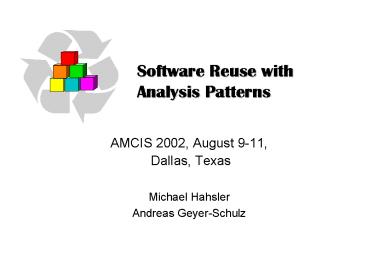Software Reuse with Analysis Patterns - PowerPoint PPT Presentation
1 / 18
Title:
Software Reuse with Analysis Patterns
Description:
Virtual Library III. Design. Separation between the three main components ... Link collection for conferences with meta information, old conferences are ... – PowerPoint PPT presentation
Number of Views:22
Avg rating:3.0/5.0
Title: Software Reuse with Analysis Patterns
1
Software Reuse with Analysis Patterns
- AMCIS 2002, August 9-11,
- Dallas, Texas
- Michael Hahsler
- Andreas Geyer-Schulz
2
Contents
- Introduction Domain Knowlege Reuse
- Analysis Patterns
- Examples for Analysis Patterns
- Quantifying the Benefits of Analysis Patterns
using two Applications - Conclusion
- Research Questions
3
Domain Knowledge Reuse
- Domain Analysis Discovering common elements
across a domain. Neighbors (1984) - Application Reuse of non-code artifacts such as
- Specifications
- Use cases
- Analysis models
- Design
- Benefits Produce more reliable and flexible
software at reduced time-to-market - Analysis Patterns as a method to support domain
knowledge reuse
4
Analysis Patterns
- Similar to Design Patterns
- Martin Fowler (1997) Capture conceptual models
in an application domain for cross application
reuse - Focus on organizational, social and economic
aspects
5
Analysis Patterns II
6
A Template for Analysis Patterns
- Pattern Name (Gamma et al. 1995 Buschmann et
al.1996) - Intent (Gamma et al. 1995) What problem does it
address? - Motivation (Gamma et al. 1995) A scenario
- Forces and Context (Alexander 1979) Should be
resolved by the analysis pattern. - Solution (Buschmann et al. 1996) Balance of
forces achieved, all relevant aspects - Consequences (Gamma et al. 1995 Buschmann et al.
1996) What trade-off exist? - Design New Design suggestions, Examples.
- Known Uses (Gamma et al. 1995 Buschmann et al.
1996)
7
Examples
- A family of analysis patterns that deal with a
series of pressing problems in - cooperative work
- collaborative information filtering and sharing
- knowledge management
- Analysis Pattern A Simple Pinboard
- Analysis Pattern Structured Pinboard
- Analysis Pattern Virtual Library
8
Analysis Pattern A Simple Pinboard
- Intent How can a dispersed group share
information efficiently? - Forces
- Efficient group communication is vital.
- Frequent meetings in person are not feasible.
- The risk of information overload is present.
9
Analysis Pattern Virtual Library
- Intent A Virtual Library is used to provide
easy access to distributed information sources. - Motivation At a university much research and
teaching material is available online, but most
of it is hard to find... - Forces
- Need for a central access point to dispersed
information. - Independent information provider with different
objectives and using different technologies. - High change rate of the provided information.
10
Analysis Pattern Virtual Library II
- Solution
- Consequences
- Information objects physically stay with their
owners. - Consistency problems.
11
Analysis Pattern Virtual Library III
- Design
- Separation between the three main components
- Facade pattern, Interpreter pattern, Visitor
pattern
12
Quantifying Benefits of Analysis Patterns
- Data from the implementation of two small
information systems based on the Analysis Pattern
Virtual Library - Analyze Code Reuse as an indicator of overall
Reuse - Boehm's COnstructiv COst MOdel to quantify
benefits (lines of code -gt effort in man months)
13
The Analyzed Projects
- Real Projects from the Virtual University Project
at the Vienna University of Economics and BA
14
The Calendar of Events
- Link collection for conferences with meta
information, old conferences are archived
automatically. - Perfectly covered by the analysis pattern Virtual
Library.
15
A Digital Library
- Massive changes necessary
- components necessary to store and manage the
actual documents
16
A Digital Library II
- In use for Working Papers and PhD
Thesishttp//epub.wu-wien.ac.at
17
Conclusion
- Libraries, components, frameworks, design
patterns, and other similar methods are
indispensable today - Analysis patterns to document domain knowledge in
a structured and make it reusable - We provided evidence that analysis patterns offer
a significant code reuse potential (between 49
and 91 for our small examples)
18
Research Questions
- How analysis patterns can help to provide a
common vocabulary for system developers and
users? - How analysis patterns can help to classify and
organize documented domain knowledge to make it
easily accessible for reuse? - How analysis patterns can help to teach effective
analysis strategies? - How analysis patterns can help to describe and
understand large systems?































